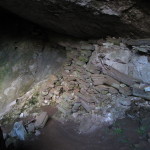
There’s but one road running through the small town of Sagada, home to one of the six traditional tribes of the highlands of northern Luzon. To get there, you meander along the precipitous sides of volcanic hills, climbing at altitudes of 1500 to 2000 meters.
Just outside of town, a young member of the local tribe, dressed more in hip-hop style than any kind of traditional costume, led us down a short steep trail to see a set of cave coffins. Funerals for his people meant carrying the dead to a cave, where his coffin was added to a haphazard stack, not buried in the ground. In another spot, back down the road, he pointed out a set of six coffins hung in a hollow of a remarkable limestone mound of jagged peaks. One family had selected that place for their dead, raising them higher perhaps so they were nearer heaven. Other sets of hanging coffins were visible from a nearby cemetery.
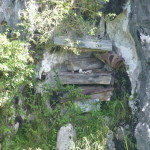
The tribespeople believed that the dead went on to a life after death, so a womb-like cave was a fitting place to put them, after their bodies were manipulated into a fetal position – as at their first birth – and inserted into a hollowed tree trunk. Burying in the ground would not let their spirits rise.
Even more interesting are the wakes held during the week between the death and burial. The family straps the dead person into a chair within its home, so the other villagers can visit to relate stories of the dead’s good deeds or bad. This public praise or shaming certainly told the living how to behave, if the lessons might be lost on the subject.
All such practices had continued though our guide’s tribe had long been converted to Anglicanism by priests who worked this area. And the rituals were giving way to Christian forms of burial. “Where will you go?” we asked him. “To the caves,” he asserted. “I prefer the old way.”
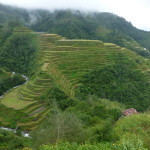
We found the highlands to be an area of extraordinary beauty as well as rugged, demanding farming. We also found how various forces continue to transform the old ways: the pressure of western religious practices, the intrusions of modern life and, oddly, the nostalgic demands of tourists to see those old ways.
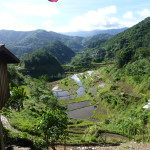
At the heart of the highlands, north of Sagada around Banaue, climbing all over the lush bumpy hills are the magnificent rice terraces of the Ifugao people. The terraces are flat sections carved some two centuries ago into the overlapping volcanic mounds throughout the area. They were shaped along the contours of the hills and terraced, so that they appear to be steps for giants to ascend from valley clefts to mountain tops.
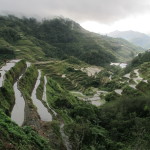
A visual and engineering marvel, the rice terraces have received UNESCO World Heritage designation.
Traditionally the village of tribal farmers nestled below in a cluster of small thatched roof huts, with a wood-walled living area suspended on stilts above an open storage space. We had seen the like all over southeast Asia, particularly among the hill tribes of Thailand and Vietnam.
To visit one of these villages, Batad, we followed the main road east from the central large town of Banaue. The road had long been just packed dirt; now parts of it had been replaced with roughly poured concrete. Construction work was ongoing and slow. In sections, huge buttressing walls tried to prevent more of the landslides endemic to the hillside, those that dump yet more rock and tree debris down from above or those that undercut support from below the road. We saw plenty of both.
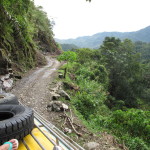
Only construction trucks and the surefooted 4WD buses known as jeepneys could safely plow through the remaining dirt sections, with their jarring bumps and soft mudholes gouged by recent rains. Even those vehicles often flirted with dizzying drops at the edge of the road. Yet, we rode on the roof of our jeepney like many of the locals, dozens of whom often throng on top, reasoning that the bus itself was little protection should we careen over the side.

Once at Batad, or at least a row of a dozen or so concrete block houses hanging on concrete stilts over the precipice, we descended into their terraces.
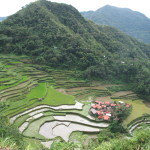
From above, especially as morning or afternoon light slants along the terrace edges, all is sharply defined, the walls and their dark shadows sinuously following the curves of the hillsides. You can see the stray red bushes planted in celebration of good harvests and hopes for more of the same; you can admire each level’s gleaming mass of rice shoots spiking upward level by level, alternating with other unplanted levels’ mirror-like pools.
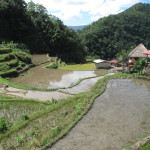
As we descend into them, however, the terraces seem less mystical and very human. We discover human-sized steps nearly hidden at the margins of the terraces. We first hear and then finally notice the rapid flow of water in channels along the edges as well, a sophisticated irrigation scheme to direct the right amount of water to the right plateau.
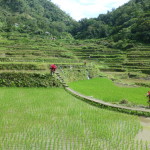
We see the rough man-made walls of rock and dirt, holding the terraces together and keeping the water in for the rice, from just a meter high, ranging up to several meters tall, depending on terrain. The fallow pools show a different life, for these are stocked with crab, shrimp and milkfish.
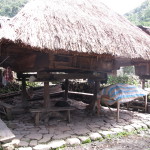
And you see the conflicts affecting the old ways among these ancient terraces. Down in the valley where the water flows, the thatched roofs had given way to corrugated tin, much easier to make and maintain. Some of these had been newly re-thatched, with funding from government tourist agencies, so that visitors could see the old ways they romantically come here to view. We climbed back up the terraces alongside villagers who had descended for church services in the valley, but were returning to the concrete structures which they now preferred at the road. There they enjoyed quicker and quicker access to Banaue, as the concrete road took shape, where modern food and drink would continue to change their diets: the ubiquitous sugary coke, the burgers, the biscuits and chips, or french-fries.
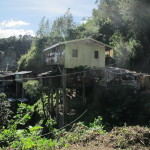
Meanwhile, the road was also opening up a channel for more and more tourists wanting to see the old ways that have been rapidly changing. Tourism – guiding visitors around, then making and selling them souvenirs – offers a much easier source of wealth than the painstaking and back-breaking work of rice farming.
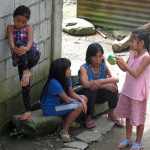
Mandatory education helps teach many of the young to prefer life in the cities or gives them the option to find prosperity outside the country. The signs of such choices are everywhere, as the fanciest homes in the hills often belong to those who left to work overseas, then returned with considerable wealth. All around Banaue, we saw posters raising awareness of how such changes threaten the terraces: they now produce just 30% of their former yield.
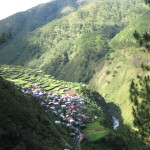
In the higher, dryer altitudes south of Sagada and its hanging coffins, villagers have carved terraces that are quite different in look and purpose. These more rectangular plots ignore the contours of the hills and are used to grow vegetables such as cabbage and sweet potatoes, all in sensible rotations to avoid depleting the fertility of the land. The effect on a visitor is still awe-inspiring, for the innumerable green plateaus cover virtually every mountain in sight.
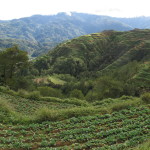
To appeal to tourists, locals have even removed trees and other visual barriers that once hid these vegetable terraces from view. The “old way” here, we learned, dates only from the 1950s when Chinese farmers began to imitate the rice terracing of their neighbors, before they themselves were chased out by resentful Filipinos.
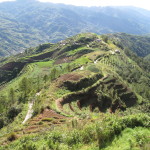
Though the result is visually impressive, you get a feeling that the carving up of the landscape has ran amok, almost like a greener kind of strip-mining, running along the vertiginous slopes as much as the flatter tops, for valley after valley. And it’s quite commercialized: ads for fertilizers and pesticides of all sorts to ensure productivity cover shop walls in towns and adorn trees along the road.
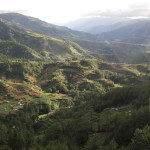
Though rituals like the cave burials survive, the “old ways” have long been under pressure to change or become tourist attractions. The Bontoc people, for example, are considered the last of those tribes who practiced headhunting, the removal of their enemies’ heads in order to demonstrate battle prowess or extract vengeance. That practice, along with tribal conflicts, was outlawed long ago by the government as murder.
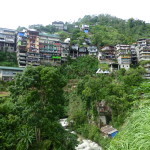
Other old ways, like “second burial,” continue while awkwardly accepting tourism and change. The second burial, among some tribes, is when the bones of the dead are dug up a few years after the first burial. The family of the dead brings the bones back home wrapped protectively in a blanket, where they act as a sort of guardian spirit to ward off troubles. So, we walked down to another Ifugao village at Tam-An to “see the bones.” After a zealous greeting by villagers at a souvenir shop filled with wooden carvings and their other crafts, we descended further into the village among houses that had recently been restored to their old form a few months back.
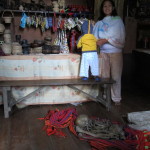
At the first house, we were greeted by a young woman, her two year old child in tow. She told us briefly about the second burial practice and asked if we wanted to see the bones, “for a fee,” she cautioned. Out of a back room, she emerged with a large red cloth bundle that contained the bones of her great-great grandfather, who died in the late 1940s. She then carefully unwrapped for us the elaborately tied bundle to show off its orderly heap of bones (“see here’s the arm, here’s a hip,” she noted with some pleasure and marvel). Then it was time for her to collect the fee of 100 pesos, about $2.50. She invited us to go with guides into their rice terraces, but we excused ourselves, passed the eager souvenir sellers once again and climbed back to our hotel.
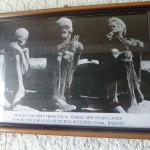
The Ibaloi took a different tack. Their practice of mummification – salting and smoking the dead somewhat like fish – also ceased centuries ago. Over the years, the mummies had become yet another strong tourist attraction, but the tribe eventually felt something was amiss. They came to believe that the exposure of their ancestors to tourists had been causing natural disasters and other troubles in the country, so they’ve now banned viewings except for one mummy in the Baguio regional museum. Maybe they have the right idea.
(Also, for more pictures from the Philippines, CLICK HERE to view the slideshow at the end of the Philippines itinerary page.)


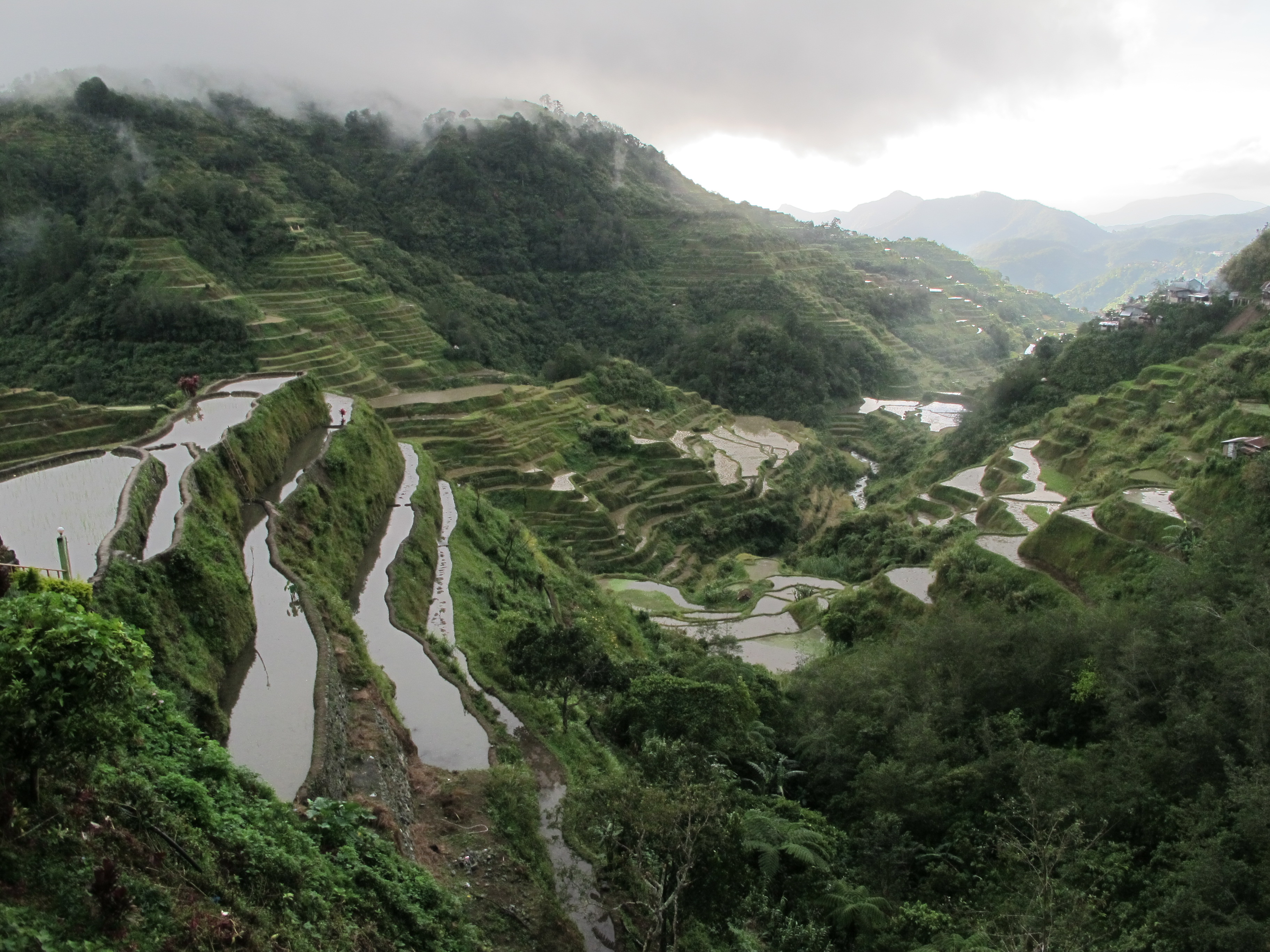

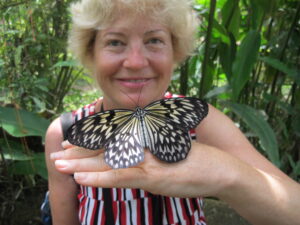
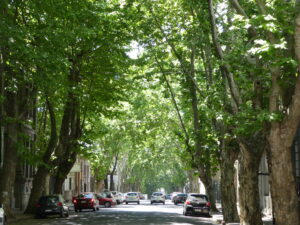
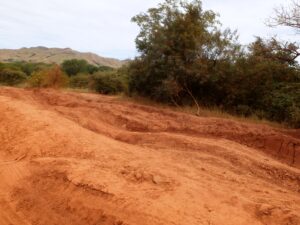
Great story….like the pix. Does the coffin really need a sign that says “Do not open or remove anything?” Also, I’m not sure what is crazier, strapping a dead person into a chair, or bringing home their bones. I’m pretty sure it’s the former.
We liked the social lesson that goes with strapping in the dead person, and it’s not much crazier than a traditional Irish wake I suppose. As for coffin, you can never trust those wild tourists.